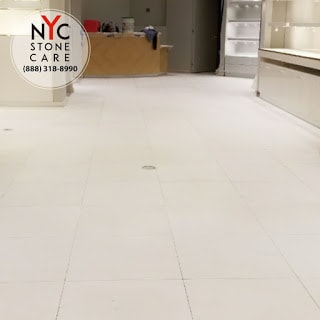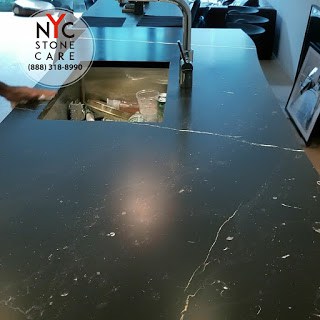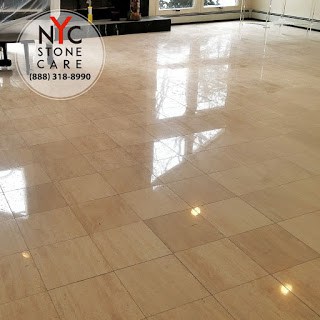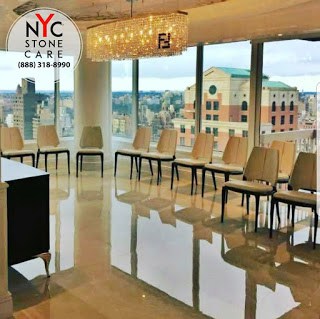
What kind of finish should you choose for your natural stone?
It can get a bit confusing whenever you are going to have your stone floor, countertop, table, walls, etc… refinished and the company asks what kind of finish you’d like to have on your stone.
Even though, most companies will recommend you keep the same finish the stone originally had. You may choose to change its appearance at any time for any reasons.
Most natural stones can be honed, high-honed, polished or high-polished. It is true that some natural stones will end up with different shined finishes than others, where some may seem glossier and other stones less glossy, but most stone surfaces accept the finishes mentioned in this article.
It’s common to have clients ask us how does the finish affect the overall look of their stone surfaces after the restoration process is completed and the pros and cons of each finish.
As much all the explanation will be given to the client on-site, sometimes it is not enough to paint the exact picture of these different types of finishes.
We, at NYC Stone Care, have put together this article in hope to help you choose the correct finish for your natural stone surface.

A Honed finish floor at Bernardaud Store on Park Avenue
What is a honed finish?
Most granite and marble has a highly polished surface. In some applications, a honed finish may be appealing in some situations.
A honed stone surface has had the final stages of polishing removed to achieve a textured, dull surface, more towards the natural look as found once extracted from the mining site.
Honing a stone surface should be applied whenever there is a need to hide constant etch stains caused by acidic liquids, in high-traffic areas to blend scratches or simply for aesthetic reasons.
This finish is commonly applied in restaurants or places where the surface scratches easily or is in constant contact with acidic compositions, such as tomato sauce, vinegar, wine, or any composition on an acidic pH scale.
Etch stains tend to blend better with a matte surface since the burn mark caused by these etchings will not show as much on an already matte surface. In some situations, honing a stone surface will require less regular maintenance.
Extending the longevity of the refinished surface can save the client money in the long run by extending the gap between each required maintenance. However, customers should be aware that honing certain stones will eliminate the patterns and colors on the surface, especially for granite, and make cleaning slightly more difficult. This is due to the pores of the stone being opened and susceptible to more dirt penetration.

A High Honed Nero Marquina Marble Island at Xoco Building Downtown Manhattan
What is high honed finish?
In order to get a high honed finish, the honing process will take a few more steps with different grids of diamonds depending on the stone.
High-honing a stone surface is done when the customer wants to have the longevity of a honed finish surface and still be able to see some gloss on the stone.
Since this process involves higher diamond grids, the stone pores are slightly more closed than a honed surface, thus being slightly harder for dirt to penetrate the stone. However, scratches or etch stains will be slightly visible to the eye.
This process is applied on any surface and on any occasion where the durability and aesthetics are required. Customers should be aware that high-honing certain stones, especially granites would eliminate the patterns and colors on the surface, and make cleaning slightly more difficult but easier than a honed finished surface.

Travertine Floor Polished
What is a Polished finish?
It’s a smooth finish that forms a reflecting surface; usually obtained by an application of a series of high grid diamonds and prolonged mechanical buffing of a stone surface on which there are no gaps in between diamond applications.
This is the most commonly seen surface since it has a rich and sophisticated look. A polished finished stone surface can be found on floors, countertops, vanity tops, walls, in lobby floors, on commercial or residential establishments.
This surface is easy to clean on a daily basis but does require more professional maintenance since any etch stains or scratches will be very visible to the naked eye.
The use of high grid diamonds makes the pores of the stone tighter, thus being more difficult for stains and dirt to penetrate the stone. Most of these polished surfaces only require water and a damp cloth with a pH neutral soap to clean it. Very easy daily maintenance, but it should be handled with care when it comes to the acidic solution as these will etch the stone right away if dropped on the surface.

A High Polished Marble floor at a Manhattan Penthouse
What is a High polished finish?
Is a method of surface finishing that brings a “mirror-like” shined finish, this is accomplished by using a series of high grid diamonds and a chemical reaction on the surface of the Stone, this chemical reaction is called Crystallization.
Crystallizing a stone creates a microfilm on the surface, which makes it more solid and durable. This procedure is done after all other procedures mentioned above are completed.
Every single diamond grid is applied on the surface; usually, for a beaten surface, the technician will start the restoration process on a 50 grid diamond or lower, and go up to a 10 thousand grid diamond. This will make the stone pores very tight and very hard for dirt to penetrate the stone.
Once the process is done, a stone buffing and polishing will take place. For last the Crystallization will be done on the surface.
The entire process will require extras steps, but the surface will be very durable and with a mirror-like finish. As any polished surface, attention should be paid to acidic etching, since the stone has been Crystallized, it will be harder for the stone to etch if any acidic liquids drop on the surface, but the solution should not be let to dry on the surface as it will etch it. Visible scratches are also a common issue with polished surfaces, as they will be more visible to the naked eye.
Are you wondering if it’s time to work on your marbles and natural stones? Deciding when to work on your old stones can be tricky. In most cases, you may not even notice that these stones need restoration or maintenance work! An expert can point you in the right direction!
Marble, Granite, Terracotta, Soapstone, Limestone, and Slate all behave similarly. They may be ruined and you won’t even notice!
Don’t worry; one of our experts is willing to talk to you over the phone. We can also come over to your location to take a look. Our experts will tell you exactly if these stones need restoration, repair or just maintenance. You will also be able to get a free estimate on the spot.
Sounds awesome, right? We want you to try it today.
When you call us, we will let you know if your stone needs restoration or not. That’s not all, we will also teach you how to clean and maintain your stone to look beautiful. Just dial (888) 318-8990 and one of our experts will talk to you for free! We are always available from Monday to Friday during work hours.

